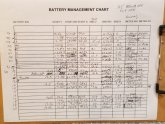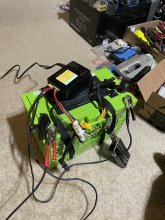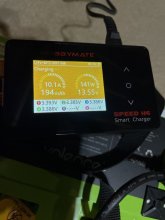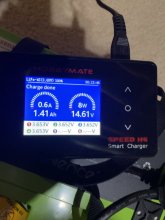Why do I need resistors?
Changing over to a MPP Solar LV5048 Split Phase Inventer which has 2 80 Amp MPPT chargers in it. Currently running a Outback 3524 with 2 FM80-150's. Array is 6 sets of 3 250 Watt panels on West roof and adding 6 sets of 3 160 Watt panels on East roof.
I'm not sure how that inverter would handle without a resistor but you'll have a very large battery Bank so I'd recommend getting the resistor. Buy three of the ev200 contactors from eBay with, economizers make sure it has the economizer. Put the charge contactor between the panels and the inverter. if one of the cells goes over voltage the BMS will open the contactor and disconnect the solar panels. Set it to charge from the generator to a lower voltage then the panel so you don't have to worry about any cell over-voltage issues when you're running the generator.
Set the inverter to shut down at 50 volts. I'm assuming it's charger will continue to function even when the inverter shut down because the volts fell below 50.
use 2 contactors between the battery and the inverter. one of the contactors would be for the pre-charge resistor and the other would be for the main connection.
Otherwise the BMS is pretty self-explanatory. You've already highlighted the wires you need and the Mueller PDF file clearly states that the ones they highlighted in red and black are required for it to function. you'll probably want to put a little toggle switch on one of the little 12 volt wires to the BMs in order to power it on and off.
You should not take 12 volts from one of the valence batteries out of the string. Get a 48 volt to 12 volt Buck converter of 7 amps or more output. connected to the contactor for it's 48 volt Supply so that it's Supply gets shut off if the BMS decides to shut everything down. Hook up a momentary push button that connects the pre-charge resistor relay main studs together. This will be the button you push in order to turn everything on. You'll have to hold it down long enough for the BMS to boot up and when you hear the BMS click the pre-charge contactor you can release the button.
Your BMS connector that only has 4 wires coming out is for the contactors. If you want to get fancy you would add four more wires and then you'd have enough to power all 4 contactors but you'd only need at most three. Pros and cons are that contactors do use a few Watts. the precharge contactors aren't an issue because they're only on for 2 seconds and you won't need a precharge contactor between the panels and the inverter.
.
I haven't experimented yet with how the charge contactor functions compared to the main contactor but I'm hoping that you could use the pair to your benefit. like put the charge contactor between the panels and the inverter and put the main contactor between the inverter and the batteries. I would hope that in an over voltage situation the BMS would only open the charge contactor. Because if it left the main contactor connected the inverter would remain on and be able to bring the battery voltage down. this would take some actual Hands-On experimentation to decide if it functions the way we want it to because the manual is not clear enough.
the reason you may need to charge contactor to disconnect the panels is because most systems cannot be connected to panels when there's no battery connected. So hopefully that charge contactor will open anytime the main contactor opens. If not then you'll be forced to put the main contactor between the panels and the inverter. then you would have no contactor between the batteries and the inverter in this would be bad if the BMS had to shut everything down and couldn't. not really a problem if you trust your inverters low voltage cutoff and you said it high enough like 50 volts. Not really a problem if you're close by to monitor things and you'll realize when things get shut down. you'll probably want to hook a speaker to the alarm output of the BMS to get your attention. that's the last thing you want is the contactor to open and disconnect the panels without you knowing and while you're using up all the battery power. I really do have some experimenting left to do on this situation. there's lots of ways to go about it to make everything function properly even if the BMS doesn't do it naturally. We still have no confirmation that these bms's prevent charging while freezing.
Do you know if your hybrid inverter can handle being disconnected from the batteries while the solar panels are still connected?







